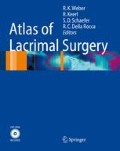1.4 Conclusions
The human efferent tear ducts are part of the lacrimal system. They consist of the upper and the lower lacrimal canaliculus, the lacrimal sac, and the nasolacrimal duct. As a draining and secretory system, the nasolacrimal ducts play a decisive role in tear transport and nonspecific immune defense. In this context the integrity of the mucosa as source of mucins and trefoil factor family peptides is of great importance with regard to tear drainage. Moreover, components of tear fluid are absorbed by the epithelium of the nasolacrimal passage and are transported into a surrounding vascular system. This system is comparable to a cavernous body that is subject to autonomic control and regulates tear outflow. Tear duct-associated lymphoid tissue (TALT) is present in the efferent tear ducts, displaying the cytomorphological and immunophenotypic features of mucosa-associated lymphoid tissue (MALT).
Preview
Unable to display preview. Download preview PDF.
References
Akiyama J, Hoffman A, Brown C, Allen L, Edmondson J, Poulain F, Hawgood S (2002) Tissue distribution of surfactant proteins A and D in the mouse. J Histochem Cytochem 50:993–996
Ayub M, Thale A, Hedderich J, Tillmann B, Paulsen F (2003) The cavernous body of the human efferent tear ducts functions in regulation of tear outflow. Invest Ophthalmol Vis Sci 44:4900–4907
Belmonte C, Aracil A, Acosta C, Luna C, Gallar J (2004) Nerves and sensations from the eye surface. Ocular Surface 2:248–253
Gipson IK, Hori Y, Argüeso P (2004) Character of ocular surface mucins and their alteration in dry eye disease. Ocular Surface 2:131–148
Hoffmann W, Jagla W (2002) Cell type specific expression of secretory TFF peptides: colocalization with mucins and synthesis in the brain. Int Rev Cytol 213:147–181
Langer G, Jagla W, Behrens-Baumann W, Walter S, Hoffmann W (1999) Secretory peptides TFF1 and TFF3 synthesized in human conjunctival goblet cells. Invest Ophthalmol Vis Sci 40:2220–2224
McCulley JP, Shine WE (2003) Meibomian gland function and the tear lipid layer. Ocular Surface 1:97–106
McDermott (2004) Defensins and other antimicrobial peptides at the ocular surface. Ocular Surface 2:229–247
Paulsen F (2003) The nasolacrimal ducts. Adv Anat Embryol Cell Biol 170:1–106
Paulsen F, Berry M (2006) Mucins and TFF peptides of the tear film and lacrimal apparatus. Progr Histochem Cytochem 41:1–56
Paulsen F, Corfield A, Hinz M, Hoffmann W, Schaudig U, Thale A, Berry M (2003) Characterization of mucins in human lacrimal sac and nasolacrimal duct. Invest Ophthalmol Vis Sci 44:1807–1813
Paulsen F, Corfield A, Hinz M, Hoffmann W, Schaudig U, Thale A, Berry M (2004) Tränenabfluss — Bedeutung von Muzinen und TFF-Peptiden. Ophthalmologe 101:19–24
Paulsen F, Föge M, Thale A, Tillmann B, Mentlein R (2002) Absorption of lipophilic substances from tear fluid by the epithelium of the nasolacrimal ducts. Invest Ophthalmol Vis Sci 43:3137–3143
Paulsen F, Hallmann U, Paulsen J, Thale A (2000) Innervation of the cavernous body of the human efferent tear ducts and function in tear outflow mechanism. J Anat 197:373–381
Paulsen F, Hinz M, Schaudig U, Thale AB, Hoffmann W (2002) TFF-peptides in the human efferent tear ducts. Invest Ophthalmol Vis Sci 43:3359–3364
Paulsen F, Langer G, Hoffmann W, Berry M (2004) Human lacrimal gland mucins. Cell Tissue Res 316:167–177
Paulsen F, Paulsen J, Thale A, Tillmann B (2000) Mucosa-associated lymphoid tissue (MALT) in the human efferent tear ducts. Virchows Arch 437:185–189
Paulsen F, Pufe T, Schaudig U, Held-Feindt J, Lehmann J, Schröder J-M, Tillmann B (2001) Detection of natural peptide antibiotics in human nasolacrimal ducts. Invest Ophthalmol Vis Sci 42:2157–2163
Paulsen F, Schaudig U, Thale A (2003) Drainage of tears: impact on the ocular surface and lacrimal system. Ocular Surface 1:180–191
Paulsen F, Thale A, Hallmann U, Schaudig U, Tillmann B (2000) The cavernous body of the human efferent tear ducts: function in tear outflow mechanism. Invest Ophthalmol Vis Sci 41:965–970
Paulsen F, Thale A, Kohla G, Schauer R, Rochels R, Parwaresch R, Tillmann B (1998) Functional anatomy of human duct epithelium. Anat Embryol 198:1–12
Stern ME, Beuermann RW, Fox RI, Gao J, Mircheff AK, Pflugfelder SC (1998) The pathology of dry eye: the interaction between the ocular surface and lacrimal glands. Cornea 17:584–589
Stoeckelhuber M, Stoeckelhuber BM, Welsch U (2003) Human glands of Moll: histochemical and ultrastructural characterization of the glands of Moll in the human eyelid. J Invest Dermatol 121:28–36
Sullivan DA, Sullivan BD, Ullman MD, Rocha EM, Krenzer KL, Cermak JM, Toda I, Doane MG, Evans JE, Wickham LA (2000) Androgen influence on the Meibomian gland. Invest Ophthalmol Vis Sci 41:3732–3742
Thale A, Paulsen F, Rochels R, Tillmann B (1998) Functional anatomy of human efferent tear ducts: a new theory of tear outflow. Graefe’s Arch Clin Exp Ophthalmol 236:674–678
Tillmann B (2005) Atlas der Anatomie. Springer, Berlin Heidelberg, New York
Lüllmann Rauch R (2003) Histologie. Thieme, Stuttgart
Author information
Authors and Affiliations
Editor information
Editors and Affiliations
Rights and permissions
Copyright information
© 2007 Springer-Verlag Berlin Heidelberg
About this chapter
Cite this chapter
Paulsen, F. (2007). Anatomy and Physiology of the Nasolacrimal Ducts. In: Weber, R.K., Keerl, R., Schaefer, S.D., Della Rocca, R.C. (eds) Atlas of Lacrimal Surgery. Springer, Berlin, Heidelberg. https://doi.org/10.1007/978-3-540-68215-8_1
Download citation
DOI: https://doi.org/10.1007/978-3-540-68215-8_1
Publisher Name: Springer, Berlin, Heidelberg
Print ISBN: 978-3-540-26255-8
Online ISBN: 978-3-540-68215-8
eBook Packages: MedicineMedicine (R0)

